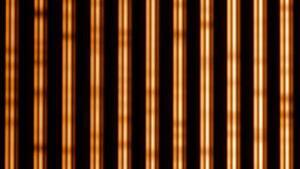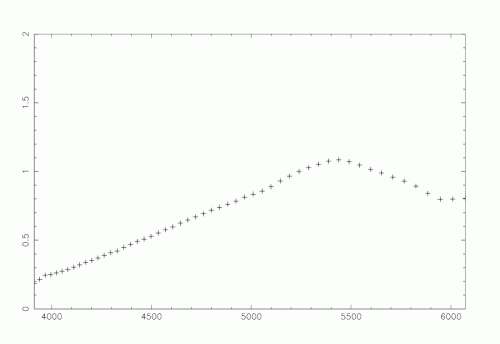| THE ING NEWSLETTER | No. 3, September 2000 |
|
|
SCIENCE |
|
|
|
| Previous: | INTEGRAL: A Simple and Friendly Integral Field Unit | Up: | Table of Contents | Next: | UltraDAS and ING FITS Headers |
Other available formats: PDF | gzipped Postscript
Fibre Feeding the UES
Nicholas A. Walton (ING), Andrew Collier-Cameron (University of St. Andrews) and Meir Semel (DASOP, Obs. Paris-Meudon)
This report summarises the recent successful deployment of a fibre feed to the Utrecht Echelle Spectrograph (UES). The main advantage of this feed, as opposed to the conventional Nasmyth direct feed, is that the starlight is spread along the slit, reducing sensitivity to flat field errors, and allowing increased integration times on bright objects. The prototype setup, which uses a 33-m fibre and is optimised for wavelengths around 5500 Å, gives throughput at least as good as conventional slit spectroscopy with the more efficient of the UES de-rotators between 5000 and 6000 Å. There is significant attenuation of the light below 5000 Å, but this could be improved significantly by using a shorter fibre with better blue transmission.
1. Introduction
UES is mounted at the Nasmyth platform of the 4.2-m WHT. In normal use it is fed by light passing through one of two de-rotators onto the slit unit. Historically the full field de-rotator suffered from poor throughput. A new high throughput de-rotator was commissioned in December 1997, offering throughputs of ~95% over the wavelength range 300–1100 nm. For details see the ING web pages at http://www.ing.iac.es/~crb/wht/derot.html.
In normal use the light from a point source falls on the slit, with unavoidable slit losses. In good seeing, the point source will project to only two or three pixels in the spatial direction. For bright objects this can limit the maximum exposure times obtainable, due to saturation on the peak pixels. It is possible to widen the spatial profile by defocusing the telescope, but this increases slitlosses. In the normal case this may not be a problem. However, for programmes studying bright sources, but looking for underlying effects from, for example, faint companions, obtaining the maximum light from the source is imperative, especially for temporal studies.
The work of Cameron and collaborators involves the detection of reflected light signatures of extra-solar planets. It is important to maintain observing efficiency by spreading starlight along the slit. This allows increased exposure times before saturation occurs, and minimises flat fielding errors. In the normal use of UES, this spreading of the light is achieved by using the auto-guider to move the star up and down the slit during the exposure. The disadvantage is that the spatial profiles vary between exposures. Also, the method is not robust to poor weather conditions, where the auto-guider can lose the star during the dithering at times of poor transparency (the auto-guider integration time needing to be short). Finally the optical paths followed by the science and calibration light are different, resulting in displacements between them of up to 3 pixels on the detector. This introduces difficulties when flat-fielding to high precision.
An alternative method of feeding UES is by employing an image slicer to spread the starlight along the slit. This could be a direct feed from Nasmyth, but this would involve a significant re-design of the UES Acquisition and Guidance (A&G) unit. The approach described here, employing a fibre feed from the Cassegrain focus of the WHT, only involves the removal of the UES A&G unit.
2. The UES Fibre-Feed
The prototype fibre feed developed for the WHT consists of the same fibre and image slicer designed and built by Semel's team at the Paris Observatory, Meudon. The primary use of the system has been for circular spectropolarimetry with the Semel visitor stellar polarimeter (Semel et al., 1993, A&A, 278, 231), and later with UCLES at the AAT for Zeeman-Doppler imaging campaigns (e.g. Donati et al., 1997, MNRAS, 291, 658). The fibre feed described here is also similar to the fibre link developed for ESPaDOnS, see: http://webast.ast.obs-mip.fr/magnetisme/espadons.html, the fibre-fed Echelle spectro-polarimeter deployed at the CFHT. The probe for mounting the fibre on the ISIS dekker slide was also designed and built at Meudon by F. Rigaud.
The input end of the fibre is located in a mount which fits in to the dekker slide within the slit unit of the WHT's ISIS spectrograph. The entrance aperture to the fibre projects to a circle with a diameter of 1.3 arcsec on the sky.
The fibre is run from the Cassegrain to Nasmyth foci of the WHT. At the exit end, the image slicer is mounted on a beam attached to the UES de-rotator mounting ring. Prior to installation of the image slicer, the UES de-rotator and and A&G unit are removed, to enable direct access to the UES slit assembly. The starlight is sliced such that three slices are projected into UES. There is no material slit, the projection of the sliced images at the slit position at the correct f number replaces the usual spectrograph slit. Figure 1 shows how the resulting echellogram appears at the detector.
In this interim deployment, the fibre feed system is based on one optimised for a 2000 Å bandpass centred on 5500 Å. The fibre is a low-OH H-treated fibre produced by Ceram-Optec (see http://www.ceramoptec.com/) (with 100/110 micron core/cladding diameters).
2.1. System Efficiency
An exposure was acquired through
the high throughput de-rotator of ![]() Boo with a 1 arcsec slit width and 4.5 arcsec slit length, the star being
dithered up and down the slit during the length of the exposure.
Boo with a 1 arcsec slit width and 4.5 arcsec slit length, the star being
dithered up and down the slit during the length of the exposure.
A second exposure was obtained with the fibre feed system, with a 1.3 arcsec entrance aperture. Both exposures were taken in similar conditions (sky transparency, seeing and airmass at time of exposure).
The relative counts between the
two exposures are shown in Figure 2. Allowing for
the uncertainty in the seeing profiles on the two nights, it appears that
the throughput of the fibre is comparable to that of the conventional slit
long-ward of 5000 Å. However, blue losses are more severe, of order
75% at 3850 Å. This is as expected, due to the system not presently
being optimised for good transmission in the blue.
 |
 |
| Figure
1. This shows part of a UES exposure of |
Figure 2. The average relative transmission for different Echelle orders between an exposure taken with the fibre, and one taken through the de-rotator (see text for full description). These are plotted as function of wavelength in Angstroms. [ GIF | TIFF ] |
2.2. Stability
The flat fields and stellar spectra were found to occupy the same spatial location on the CCD, indicating that there was no misalignment of the stellar and calibration beams in UES. However, there was a steady drift of the spatial profile through the night, amounting to some 75 microns in 14 hours. The drift had a steady nature, indicating that it was caused by the known poor thermal control of the UES enclosure.
3. Future Upgrades
The fibre-feed described here is still experimental in nature. However, initial results were encouraging, and it proposed to employ this system in October and November 2000 as part of a planet monitoring campaign.
Modifications that are being implemented include a second fibre fed directly from the WHT's Cassegrain A&G calibration unit. This calibration unit has the provision of fibre feeding light directly into this second fibre. This will allow direct injection of calibration ThAr and tungsten light at much higher intensities. Thus time needed for calibration exposures will be much reduced.
In order to improve the throughput, the fibre length from the Cassegrain to UES is being optimised to the shortest possible length, reducing the 33-m used in May 2000 down to approximately 10-m in October 2000. Further options include changing the size of the fibre, employing fibres with better transmission in the ultraviolet, and optimising the coatings in the slicer optics.
4. Opportunities for UES
This experimental fibre feed to UES could open the way to radical changes to UES itself. With the ING's increased emphasis on developing Adaptive Optics instrumentation and wide field multi-object spectroscopy, the pressure on the WHT's two Nasmyth platforms is increasing.
As a result of the ING's Announcement of Opportunity for new instrumentation (see IWG WWW pages), a wide field optical image corrected multi-object spectrograph, MOSAIC (Sharples et al., Proc. SPIE, 4008, 2000, in press), was proposed. If constructed this instrument could be mounted at the Nasmyth platform currently occupied by UES. MOSAIC would contain an integrated AO system with a Rayleigh laser beacon. One option would enable an AO feed to be fibre fed to UES, allowing images of 0.2 to 0.3 arcsec at 6500 Å to be injected into UES.
In this case UES would be moved to a thermally and gravitationally stable location beneath the WHT. This would have potential advantages, as already described above for the feed, and for improved instrument stability.
5. Concluding Remarks
The advantages of the fibre system are that the slit profile is stable and that the calibration arc and flat field spectra are much more accurately aligned with the stellar spectra on the CCD than is the case with conventional slit spectroscopy. The poor blue throughput of the fibre fed system will be improved by further optimisation including the use of better 'blue' fibres and reducing the length of the fibre.
Further information about the fibre feed to the UES can be obtained from the UES instrument specialist, John Telting (jht@ing.iac.es).
More general information about
instrumentation developments at the ING can be found under the Instrumentation
Developments area of the ING web pages at http://www.ing.iac.es/Astronomy/,
or from the ING Instrumentation Scientist, Nic Walton.
Email contact: Nic Walton (naw@ing.iac.es)
| Previous: | INTEGRAL: A Simple and Friendly Integral Field Unit | Up: | Table of Contents | Next: | UltraDAS and ING FITS Headers |
| GENERAL | SCIENCE | TELESCOPES AND INSTRUMENTATION | OTHER NEWS FROM ING | TELESCOPE TIME |